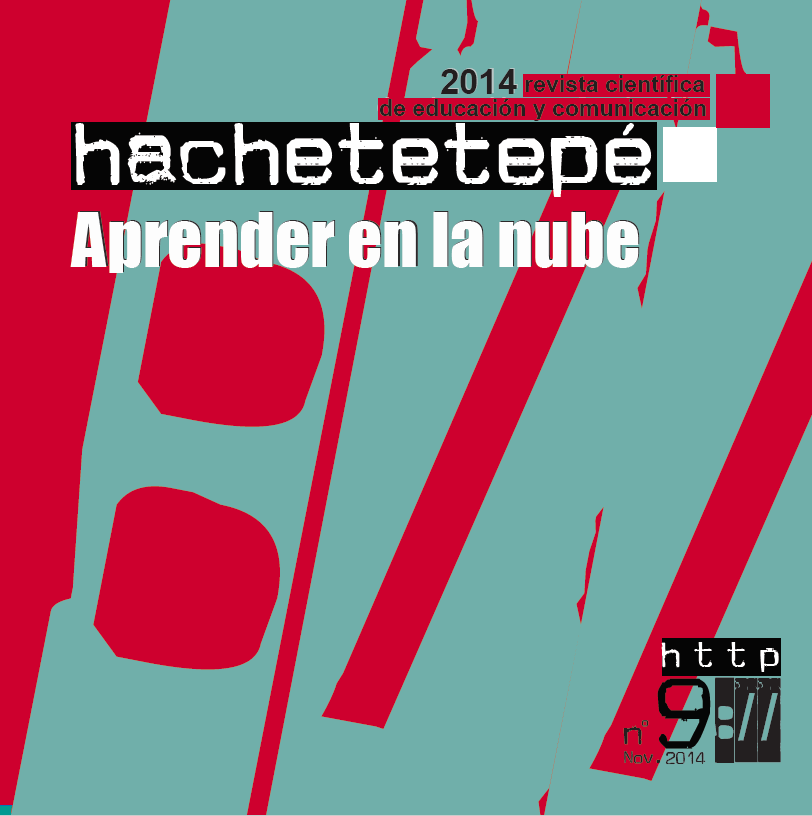Connectivism, or learning in clouds of connections
Abstract
This article presents the theory of Connectivism, purposely overlooking current academic controversies on MOOCs, a derived methodology. We present essential points of the original theory to show its relevance in our current rising networked society where connections are made ever more rapidly. We overview methodologies and guidelines to materialise connectivist learning suggested by the theory’s authors, ending with a review of limitations to the theory.
Keywords
Downloads
How to Cite
License

This work is licensed under a Creative Commons Attribution-NonCommercial-NoDerivatives 4.0 International License.
Those authors who have published with this journal, accept the following terms:
- They will retain their copyright and guarantee the journal the right to first publication of their work, which will simultaneously be subject to the Creative Commons Attribution License . They may be copied, used, disseminated, transmitted and publicly displayed, provided that the authorship, url, and magazine are cited, and are not used for commercial purposes. No derivative works are allowed.
- They may adopt other non-exclusive license agreements for the distribution of the published version of the work (e.g., deposit it in an institutional telematic archive or publish it in a monographic volume) provided that the initial publication in this journal is indicated.
- Disseminate your work through the Internet (e.g., in institutional telematic archives or on your website) once the manuscript is accepted, which may lead to interesting exchanges and increased citations of the published work. (See The effect of open access).
Hachetetepé. Scientific journal of education and communication does not charge a fee for the submission of manuscripts or for the publication of its articles.
References
Aïm, O., Allard, L., Menrath J.y Vergopoulos H. (2013). “Vie intérieure et vie relationnelle des individus connectés. Une enquête ethnographique”. Fédération française des Télécoms, diaporama, septembre 2013.(http://www.fftelecoms.org/sites/fftelecoms.org/files/contenus_lies/vie_interieure_vie_relationnelle_mai_2013.pdf.) (Recuperado en abril 2014).
Asimov, I., (1988). “Entrevista con Isaac Asimov by Bill Moyers”. (http://www.youtube.com/watch?v=1CwUuU6C4pk) (Recuperado en abril 2014).
Bauman, Z. (2013). Liquid modernity. John Wiley & Sons.
Bell, F. (2011). “Connectivism: Its Place in Theory-Informed Research and Innovation in Technology-Enabled Learning”. International Review of Research in Open & Distance
Learning, 12 (3). (http://www.irrodl.org/index.php/irrodl/article/view/902/1664) (Recuperado en abril 2014).
Berners-Lee, T. (2010). “Long Live the Web: A Call for Continued Open Standards and Neutrality,” Scientific American, November 22. (www.scientificamerican.com/article.cfm?id=long-live-the-web). (Recuperado en abril 2014).
Boyd, D. (2010). “Streams of content, limited attention: The flow of information through social media”. Educause Review, 45 (5); 26-28.
(http://www.educause.edu/ero/article/streams-content-limited-attention-flow-information-through-social-media) (Recuperado en abril 2014).
Comisión Europea. “Opening up Education –a proposal for an European Initiative to enhance education and skills development through new technologies,
(http://ec.europa.eu/smart-regulation/impact/planned_ia/docs/2013_eac_003_opening_up_education_en.pdf.) (Recuperado en abril 2014).
Castells, M. (2004). 1. “Informationalism, networks, and the network society: a theoretical blueprint”. The Network Society, 3. (http://annenberg.usc.edu/Faculty/Communication/~/media/Faculty/Facpdfs/Informationalism%20pdf.ashx) (Recuperado en abril 2014).
Chomsky, N. (2012). “The Purpose of Education”.
(http://www.learningwithoutfrontiers.com/2012/02/noam-chomsky-the-purpose-of-education/) (Recuperado en abril 2014).
Downes, S. (2012). Connectivism and Connective Knowledge: essays on meaning and learning networks. National Research Council Canada. (http://www.downes.ca/files/books/Connective_Knowledge-19May2012.pdf) (Recuperado en abril 2014).
Freire, P. (1993). Pedagogy of the Oppressed. 1970. New York: Continuum. (http://www.users.humboldt.edu/jwpowell/edreformFriere_pedagogy.pdf) (Recuperado en abril 2014).
Hernández, D. R. (2012). Socionomía: ¿vas a perderte la revolución social? (Vol. 12). Madrid: Planeta.
Illich, I. (1971). Deschooling Society. Marion Boyars, London and New York. (http://www.arvindguptatoys.com/arvindgupta/DESCHOOLING.pdf) (Recuperado en abril 2014)
Ito, M., Gutiérrez, K., Livingstone, S., Penuel, B., Rhodes, J., Salen, K. y Watkins, S. C. (2013). Connected learning: An agenda for research and design. Digital Media and Learning Research Hub.(http://dmlhub.net/sites/default/files/ConnectedLearning_report.pdf) (Recuperado en abril 2014).
Kop, R., y Hill, A. (2008). Connectivism: Learning theory of the future or vestige of the past? International Review of Research in Open & Distance Learning, 9 (3). (http://www.irrodl.org/index.php/irrodl/article/view/523/1103). (Recuperado en abril 2014).
Kop, R. (2011). “The challenges to connectivist learning on open online networks: Learning experiences during a massive open online course”. The International Review of Research in Open and Distance Learning, Special Issue-Connectivism: Design and Delivery of Social Networked Learning, 12 (3).(http://www.irrodl.org/index.php/irrodl/article/view/882/1823). (Recuperado en abril 2014).
Mackness, J., Mak, S., y Williams, R. (2010). “The ideals and reality of participating in a MOOC. In Networked Learning Conference”. University of Lancaster; 266-275. (http://eprints.port.ac.uk/5605/1/The_Ideals_and_Realilty_of_Participating_in_a_MOOC.pdf) (Recuperado en abril 2014).
Robinson, K. (2006). “Las escuelas matan la creatividad”. V. TED, Entrevistador.( http://www.youtube.com/watch?v=nPB-41q97zg) (Recuperado en abril 2014).
Roig Vila, R. (2010). “Innovación educativa e integración de las TIC: un tándem necesario en la sociedad de la información”. (http://rua.ua.es/dspace/bitstream/10045/14883/5/Roig%202010.pdf) (Recuperado en abril 2014).
Seltzer, K., y Bentley, T. (1999). The creative age: knowledge and skills for the new economy. Demos. (http://www.culturenet.cz/res/data/004/000574.pdf) (Recuperado en abril 2014).
Shirky, C. (2010). Cognitive surplus: Creativity and generosity in a connected age. Penguin UK.
Siemens, G. (2006). Knowing knowledge. (http://www.lulu.com/product/paperback/knowing-knowledge/545031?productTrackingContext=search_results/search_shelf/center/4#detailsSection.) (Recuperado en abril 2014).
Siemens, G. (2010). Conociendo el conocimiento. Ediciones Nodos Ele. (http://www. nodosele. com/editorial.) (Recuperado en abril 2014).
Trilling, B., y Fadel, C. (2009). 21st century skills: Learning for life in our times. John Wiley & Sons.
Vázquez Cano, E., Meneses, E. L. y Sánchez-Serrano, J. L. S. (2013). La expansión del conocimiento en abierto: los MOOC. Barcelona: Octaedro.






